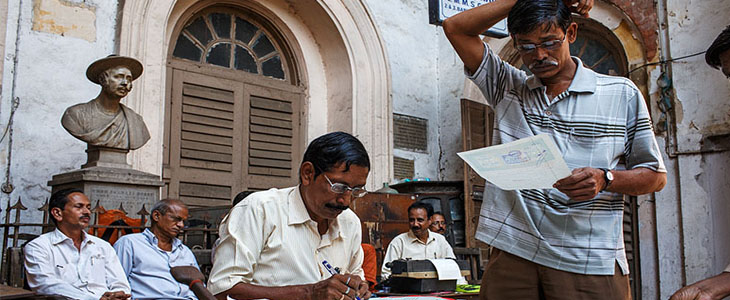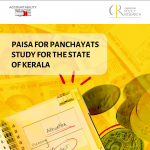
A Circuitous Journey
25 November 2016
This is the fourth blog of a five-part series to unpack the meaning of some of the frequently heard terms and phrases in the Indian bureaucracy.
Webster Definition:
Circular: A printed notice, order or advertisement given or sent to many people at the same time. In business or politics, used to inform a wide range of recipients of new policies or other important matters.
Bureaucratic Translation:
The all-important, pre-requisite order, mandatory to initiate or allow any kind of bureaucratic action. As critical to a bureaucrat to get things done as ‘Open Sesame’ was to Ali Baba.
There is perhaps nothing more important to the world of babus than that without which, nothing can ever begin. The all-important circular that acts as the official order or notice giving directions regarding any work, discussion, meeting that the bureaucracy undertakes. Much like the Ganesh Vandana (invocation to Ganesha – the Hindu God) that precedes most Hindu pujas as a rite of passage before any work can be initiated, the reciting of the ‘Circular chant’ is essential for the bureaucrat before business can well and truly begin.
This blog focusses on the treacherous journey that a circular makes through various levels in the bureaucratic hierarchy and our experience in trying to navigate every stage.
Stage 1: Where is the circular?
Armed with a plethora of background research and ready set of questions, we walk into a sarkaari office at the scheduled hour (which, if luck permits ends up being the same as the time we meet the officials). What follows is an eloquent explanation of our study (the purpose of our research) which lasts for about fifteen minutes before one is stopped mid-sentence to be asked, “Who sab toh theek hai madam, par circular hai kya aapke paas?” (All that is alright madam, but do you have a circular?). Depending on the seniority, height, and current mood of the official, the inflection of this phrase varies from saccharine sweet to bitter-gourd sour.
The essence of this deep question nonetheless, lies in the implicit understanding that the bureaucracy functions on – without a circular directing them, no study, work or research is worth wasting their time.
In an environment where officials are already inundated with more work than they can cope with, the lack of a circular implies an absence of legitimacy – used both as an escape clause, and a way of discerning the relative importance of the person/task at hand.
The end result of this mid-sentence questioning, if answered in the negative, is usually a polite request to return if and when a circular can be provided.
Often (if one is more fortunate), this is also encased in the form of a sympathy-inducing apology that assures us that we would have been spoken to, if only the official permissions were in order. Nonetheless, the tight-lipped attitude of the bureaucrat to speak about, or even listen to anything beyond his regular routine of work without a circular is indicative of the forced atmosphere of secrecy in which the bureaucracy continues to function even today. This is induced both by fear of repercussions and a tendency to put off tasks for as long as possible.
Stage 2: The circular may have arrived, but has it reached?
The process of obtaining the official stamp of a circular merits a blog post of its own. Suffice to say however; that the levels of hierarchy that one has to navigate in order to get official permissions from one person to the next would make for an epic the size of Odyssey. Months of waiting, repeat visits, mails and sanctions by various departments later, we walk into the office, beaming and armed with a copy of the official ammunition of a circular. Introduction exercise is repeated this time lasting for a good 30 minutes before we are asked, mid-sentence again, “Madam aa toh gaya hoga circular, par upload hua hai kya?” (Madam the circular may have arrived, but has it been uploaded?)
Irrespective of the fact that you may have been carrying a copy of the circular with your name and directions from the highest authorities, this stage represents a classic demonstration of the proverb, “many a slip between the cup and the lip”. At this point, the demeanor of the bureaucrat is visibly softened, given the official sanction presented. However, attempts ranging from those to ascertain the originality of the circular, to questions about the fine print that may need ‘further clarification’ at a ‘higher level’ are characteristic of this phase. This is supplemented by a generous dose of majboori (helplessness) comments regarding their inaction, considering the circular may have been printed, but has not been ‘uploaded’ to the website. The end-result is a politer request to come back when the circular has been clarified better and has ‘reached’ the bureaucrat in his official capacity.
Stage 3: Nearing the finale – but to what end?
The ultimate stage of this journey is represented by a (sometimes grudging) acceptance of the fact that all legalities and formalities are in place, and therefore some amount of time must be allotted to a discussion on the circular. However, this visit represents a conundrum of its own, reflected in the bureaucrat’s inability to decide which circular to follow. “Madam aapka circular toh theek hai, par doosre department ke circular ka kya karun?” (Madam your circular is fine, but what do I do regarding the one belonging to another department?)
As circulars are one of the most widely used sources for information dissemination, this stage represents an oft-encountered problem in the bureaucratic world – the coordination of directives issued in different circulars.
On more than one occasion, there is a genuine concern regarding the mixed messaging passed on to the bureaucrat regarding the same event making it difficult for her to juggle competing conceptions of what is the right course of action.
More complexities include previous orders prohibiting or allowing a certain action; future events that may have to be kept in mind before disclosing any information; and simultaneous guidelines from multiple ministries that are not completely in sync with, or apprised of each other’s’ work.
All this contributes to a confusion even when there is a sincere effort to help on the part of the bureaucrat. In fact, the absence of orders itself is also a source of many misunderstandings, forcing an official to err on the side of caution rather than risk consequences. The end result of this stage is usually a request for time to ensure that all misconceptions regarding ‘interpretation’ can be cleared. It is only when the last hurdle of this stage is crossed that one can truly begin work.
What is it that makes the circular such a revered and feared instrument at the same time? The need for directives and compulsive adherence to rules and regulations, particularly in the written form, is characteristic of babudom in a manner scarcely seen elsewhere. This has become so ingrained in the functioning of the bureaucracy today that actual intentions have ceased to be less important than the symbolism of ensuring that things are in order. Circulars are perhaps the most tangible form of this ‘cultural’ practice. Notwithstanding the fact that that the sheer number of such circulars, their contrasting directives and long-drawn process of issuing are impediments to ensuring the smooth functioning of the bureaucracy; For the bureaucrat, above all, circulars represent the ultimate truth: No circular, No work.
In the next blog, Vincy discusses the more crucial question of what happens once the all-important circular has been issued, the work has begun and the D-Day looms large. Watch out for her blog on how babus deal with dreaded deadlines!
Taanya Kapoor is part of the Public Administration team at Accountability Initiative. Her primary focus is on qualitative research to understand education reforms at the state level.





